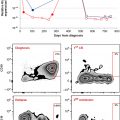Case study 17.1 Presentation with Pancytopenia
A 62-year-old man was treated for stage IIIA diffuse, large, B-cell lymphoma with six cycles of R-CHOP chemotherapy (rituximab, cyclophosphamide, doxorubicin, vincristine, and prednisone), after which he achieved a complete response. Approximately one year later, his disease relapsed, and he received treatment with R-ICE (rituximab, ifosfamide, cyclophosphamide, and etoposide) followed by filgrastim [granulocyte colony-stimulating factors (G-CSF)] to mobilize autologous stem cells for collection. He underwent an autologous stem cell transplantation following conditioning with BEAM (carmustine, etoposide, cytarabine, and melphalan). His blood counts recovered to normal. Now 4 years later, he presents with macrocytic anemia and thrombocytopenia on routine bloodwork. The peripheral blood smear shows trilineage dysplasia with extensive dysgranulopoiesis (hypogranular neutrophils), poikilocytosis, and oval macrocytes. Bone marrow aspiration and biopsy reveal 7% myeloblasts with myelodysplastic changes. Cytogenetic analysis shows a complex karyotype, including del(5q) and monosomy 7, in the majority of metaphase cells. No lymphoma is seen.
• Who is at risk for t-MN?
By definition, t-MNs occur after cytotoxic exposures. These neoplasms are thought to be the direct consequence of mutational events induced by the prior therapy. However, the exact role of the cytotoxic exposure in the development of t-MN remains unclear. The possibilities include (i) a mutational event or series of mutations entirely due to the specific DNA-damaging agent, (ii) an entirely stochastic event (i.e., happening by chance), or (iii) a host susceptible to the development of myeloid neoplasms regardless of exposures. Evidence in support of the pivotal role of cytotoxic agents includes characteristic recurring cytogenetic abnormalities induced by specific cytotoxic exposures with unique mechanisms of action. However, various germline genetic factors likely impact an individual’s susceptibility to t-MN. The functions of many of the genes known to be involved in hereditary cancer susceptibility, such as TP53, BRCA1, and BRCA2, are in various DNA repair pathways that play an important role in maintaining DNA integrity in the face of damaging exposures, whether natural and environmental or iatrogenic and therapeutic.
t-MN occurs at every age but is more commonly seen in older patients (the median age is about 61 years). Patients at risk include anyone who has previously received chemotherapy or radiotherapy (RT) alone or in combination, with the greatest relative risk observed in those treated with combined-modality therapy. The majority of patients who received RT alone had received radiation to large fields of active hematopoiesis, including the central skeleton and pelvis. Approximately half of t-MN patients have been previously treated for hematologic disorders, about 40% have had solid tumors, and a small fraction were treated for nonmalignant conditions such as autoimmune diseases, or had undergone a solid organ transplant.
• What agents have been associated with t-MN?
Alkylating agents are most commonly associated with t-MN, followed by topoisomerase-II inhibitors, such as etoposide and doxorubicin; leukemogenic potency varies between agents. t-MN has also been reported in patients who received mitoxantrone for multiple sclerosis, with an estimated incidence of 0.21%; therapy-related promyelocytic leukemia accounts for 30% of these cases. Other agents associated with therapy-related leukemia include antimetabolites such as fludarabine. Azathioprine has been linked to t-MN after use in solid-organ transplantation or for inflammatory conditions. The routine use of G-CSFs as an adjunct to chemotherapy also increases the risk of t-MN.
• What are the clinical features of t-MN?
The clinical presentation of t-MN is variable but generally resembles that of primary MDS or de novo AML. Although sometimes discovered serendipitously during routine follow-up from prior treatments, patients more often present with symptoms related to pancytopenia, including fatigue, fever, infections, easy bruising, and bleeding. The presentation also differs depending on the prior exposures. The latency period for patients previously treated with alkylating agents or RT is typically 5–7 years after the first exposure but may extend to as long as 10 years after the last exposure. In these patients, t-MN most often presents with a more insidious course resembling primary MDS with increasing pancytopenia and bone marrow failure with trilineage dysplasia. In contrast, those who previously received a topoisomerase-II inhibitor have shorter latencies, often only 1–3 years. These patients sometimes present with overt acute leukemia and high white blood cell (WBC) counts.
• How would you evaluate this patient?
The diagnosis of t-MN is made based on the assessment of peripheral blood and bone marrow samples. The bone marrow aspirate specimen should be evaluated by flow cytometry and sent for cytogenetic analysis of metaphase cells and molecular diagnostic studies. Although fluorescence in situ hybridization (FISH) assays (using a limited panel of specific DNA probes) will identify some of the more common clonal abnormalities, full karyotyping is strongly recommended. For younger patients who may be candidates for allogeneic hematopoietic cell transplantation (HCT), human leukocyte antigen (HLA) typing should be performed. Marrow blast counts of greater than or less than 20% are sometimes used to divide t-AML from t-MDS, respectively, but have no importance with regard to confirming the diagnosis of t-MN.






